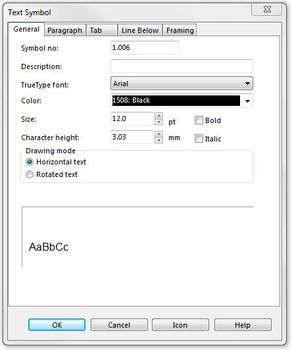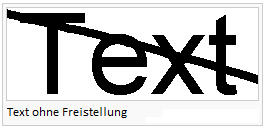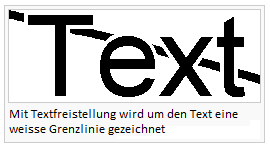Ein neues Textsymbol erstellen
Sie können mit OCAD neue Textsymbole erstellen. Wählen Sie dazu Neu im Symbol-Menü und anschliessend den Symboltyp Textsymbol im Dialog Neues Symbol. Dadurch erscheint der Dialog Textsymbol.
Darin sind folgende Optionen verfügbar:
- Allgemein: Definieren von Schrift, Schriftfarbe und Schriftgrösse
- Abschnitt: Definieren der Abschnitts-Eigenschaften
- Tabulator: Tabulatoren hinzufügen und löschen
- Linie unten: Linie unterhalb des Texts definieren
- Freistellung: Freistellung und Kombination mit einem Punktsymbol definieren
- If required, configure the options 'general', 'paragraph', 'tabulator', 'line below' and 'framing' for the text symbol.
- Once you have defined the Text Symbol, select Icon in the dialog window. The Edit Icon dialog window appears.
- Draw the icon in the 22 x 22 pixel matrix field using the various drawing tools.
- When you are finished, click OK twice. The new symbol appears in the symbol field.
General
Choose this page to define general text symbol parameters.
- Symbolnummer: Geben Sie eine Symbolnummer zwischen 0.001 und 999999.999 ein. Die Symbolnummer muss innerhalb der Datei eindeutig sein.
- Beschreibung: Geben Sie eine Symbolbeschreibung ein. Diese wird angezeigt, wenn das Symbol oder ein Objekt mit diesem Symbol selektiert wird.
- Schrift: Wählen Sie eine Schrift aus. Alle in Windows installierten Schriften stehen zur Auswahl.
- Farbe: Wählen Sie eine Textfarbe aus. Die Farben der Farbtabelle stehen zur Auswahl.
- Grösse: Bestimmen Sie die Schriftgrösse in pt oder die Buchstaben-Höhe in mm in der Box Buchstaben-Höhe.
- Fett: Aktiveren Sie diese Option für fetten Text.
- Kursiv: Aktiveren Sie diese Option für kursiven Text.
- Zeichnungsmodus
Diese Einstellung hat Auswirkungen wenn Sie die Karte drehen mit der gleichnamigen Funktion im Menü Karte.
- Horizontaler Text: Mit dieser Option bleibt der Text auch beim Drehen der Karte horizontal.
- Gedrehter Text: Mit dieser Option wird der Text beim Drehen der Karte mitgedreht.
- Bahnlegungs-Symbol: (Diese Option ist nur in Bahnlegungsprojekten verfügbar!)
- Aktivieren Sie diese Option wenn das Symbol als Bahnbezeichnung, Startnummer oder Gabelungsvariante bei einer Staffel verwendet werden soll.
Paragraph
Choose this page to define parameters for text paragraphs.
- Character spacing: Enter here a distance to be inserted between characters. If you enter 100% a space character is inserted between characters. The default value is 0%. Negative values can be inserted.
- Word spacing: Enter here the distance between words. 100% means that a normal space character is used between words. Default value is 100%.
- Alignment: Choose the alignment of the text.
- Line spacing: Enter the distance from one line to the next within a paragraph, in relation to the font size. Standard value is 120%.
- Space after paragraph: Enter the additional space after each paragraph.
- Indent first: Enter the indent of the first line of each paragraph.
- Indent other lines: Enter the indent of the other lines of each paragraph.
Tab
Choose this page to set the tabs for the text symbol. The tabs are left adjusted. A maximum of 32 tabs can be defined. If a text contains more tab characters than defined in the list, the distance to the last tab is repeated.
- To add a new tab: Enter the position and click Add. The tab is added to the list.
- To delete a tab: Click on the tab to be deleted on the list. Then click Delete.
Line Below
Choose this page to define a line which is drawn below each paragraph. (A paragraph is terminated by a hard return - the Enter key.)
- On: Check this box to get a line below the paragraphs.
- Line color: Choose a color for the line.
- Line width: Enter a line width.
- Distance from text: Enter a distance from the baseline of the text to the upper edge of the line.
Framing
Choose this page to set the parameters for text framing.
- Off: Activate this box if you don't want to use text framing.
- Line: Enter here the width (how much the framing extends outside the character) of the text framing.
- Shadow: Choose this option if a shadow to the text shall be rendered. Enter the horizontal and vertical offset of the shadow. Choose the color.
- Rectangle: Choose this option to add a rectangular background. Enter the values Left, Right, Bottom and Top if the rectangle shall overlap the text. Choose a color.
- Color:: Choose a color. To get text framing, this color must be below the color of the main font in the color table, but above the colors of any objects which you wish to cover.
- Point symbol: Check On if you want to attach a point symbol to the text symbol. Choose a point symbol.
Text framing is a method to make text more readable on maps. If - for instance - you have black text on a map, it may interfere with black line objects. Text framing can also be used for decorative effects - giving the text a shadow, for instance.
For text framing you need to understand the color table and you should have some experience in creating new colors and new symbols.
First you need two additional colors which are above the black color for symbols:
Then you can add text framing to an existing text symbol:
- Right click the text symbol and choose Edit from the context menu.
- Choose the General page. Choose "Black for text" for the text color.
- Choose the Framing page. Activate Line.
- Enter the desired framing width.
- Choose "White for text frames" in the Color box.
Selective text framing
Often text framing erases only the black color, but the other colors still come through. OCAD allows selective text framing for printing the map with spot colors (PMS or Pantone colors), by defining the appropriate spot colors. However, on the screen all colors below the framing color are erased. So beware: the appearance of the map on the screen and the printed map will be different. Selective text framing is also possible for CMYK printing. For this case you have to define your own "spot colors" for CMYK. You cannot use the automatic CMYK color separations.
Choose this page to set the parameters for text framing.
- Off: Activate this box if you want to use text framing.
- Line: Enter here the width (how much the framing extends outside the character) of the text framing.
- Shadow: Choose this option if a shadow to the text shall be rendered. Enter the horizontal and vertical offset of the shadow. Choose a color.
- Color: Choose a color. To get text framing, this color must be below the color of the main font in the color table, but above the colors of any objects which you wish to cover.
![]() For every text style, a separate symbol is required. If you modify the text symbol, then all text written with that symbol will change. See also Symbols (basic principles).
For every text style, a separate symbol is required. If you modify the text symbol, then all text written with that symbol will change. See also Symbols (basic principles).
![]() The error message: "Font not found" appears if a font is chosen that is not installed on the PC. The font needs to be installed on the PC or another font must be chosen. Otherwise the font Arial is used.
The error message: "Font not found" appears if a font is chosen that is not installed on the PC. The font needs to be installed on the PC or another font must be chosen. Otherwise the font Arial is used.



